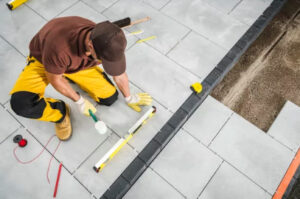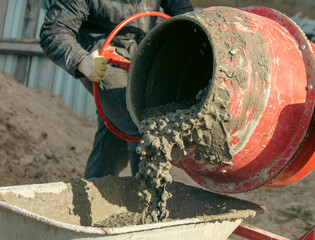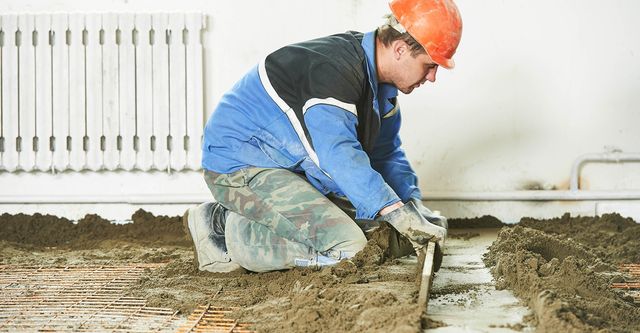 When it comes to home improvements, concrete is a unique material that offers homeowners the opportunity to make their buildings look beautiful. It is also durable and affordable. Concrete Contractors Dallas TX specializing in decorative concrete are held to a higher standard than those pouring plain gray concrete. This is because their job is not simply structural but artistic as well.
When it comes to home improvements, concrete is a unique material that offers homeowners the opportunity to make their buildings look beautiful. It is also durable and affordable. Concrete Contractors Dallas TX specializing in decorative concrete are held to a higher standard than those pouring plain gray concrete. This is because their job is not simply structural but artistic as well.
Concrete is a versatile building material that can be colored, stamped, stained, layered and polished. It can also be incorporated with other products to add texture, warmth and elegance. Decorative concrete is a cost-effective way to add an aesthetic element to floors, walls and other surfaces in homes or commercial properties.
It allows home owners and designers to customize their spaces by choosing colors and finishes that mimic sleek slate, warm tile, stone or wood. It is used to revamp patios, pool decks, driveways, countertops and garage floors. It is also becoming a popular choice to use in the interiors of homes and offices.
Increasing remodelling and renovation operations in non-residential spaces is expected to boost the demand for decorative concrete during the forecast period. This is because the concrete surfaces can be used as a base for different materials that can be added to the surface later on. This will further enhance the appeal of these spaces.
With the advancements in concrete tools, concrete stains and dyes and textures, contractors have unlimited options to create decorative concrete. For example, they can now add a textured design to concrete slabs using a plastic stamp that imitates brick or other textures. They can also add sloped drain boards or brass rails to a new concrete countertop kitchen island.
Concrete countertops are one of the most popular applications for decorative concrete. They can be cast in place at a customer’s home or pre-fabricated offsite and delivered for installation and finishing. They can be sculpted and customized with sinks, faucets, sloped drain boards and other features to suit the client’s needs.
Staining is an affordable decorative option for concrete. There are many different types of stains available, including acid staining and water based stains. Acid stains react with the concrete and change its physical makeup, while water stains simply coat the surface of the concrete.
In order to keep their costs down, decorative concrete contractors often combine multiple steps to create a finished product. For example, they might stain the concrete, score it and then apply a concrete overlay. This will create a consistent appearance and save on labor costs. However, this can lead to problems if the overlay doesn’t adhere to the concrete properly or is not durable enough for the application.
Durability
Concrete is a highly durable material that holds up well against damage and weathering. It’s also cost-efficient. Decorative concrete is a great choice for driveways, pool decks, patios, sidewalks, and more. It can mimic the look of expensive materials such as stone, brick, and wood at a fraction of the cost.
With the help of advancements in concrete tools, stains and dyes, textures, and finishes, decorative concrete allows homeowners to make their homes unique. This concrete can be etched, stamped, carved, textured, and colored to create the desired aesthetic for their homes. It can be used indoors and out, and comes in a variety of shapes and sizes.
Whether it’s a walkway, seating area, grilling station, or pool deck, decorative concrete can add the perfect finishing touch to any outdoor living space. It can be poured and formed on-site or prefabricated in a factory. It’s often used to match the architecture and color scheme of a home or commercial building.
If you are unsure of what type of decorative concrete to use for your project, talk to a professional contractor. They can provide suggestions based on your vision and budget. They can even show you samples of previous work they’ve done.
One of the most popular applications for decorative concrete is stamped concrete. It can be made to look like tile, flagstone, cobblestone, or natural stones. It’s also available in a wide variety of colors and can be finished with a color hardener, powder release, or a liquid or spray release.
Another option is to use a scoring tool to add texture to the concrete surface. This process is less labor intensive than other decorative options such as using a stencil or chiseling the concrete. This technique can be done on new or old concrete. It is important to seal the concrete properly afterward.
Another advantage of decorative concrete is that it can be used in the bathroom, kitchen, or dining room. Unlike other flooring options, it doesn’t get damaged by water and can be cleaned easily. It’s also not slippery and can withstand heavy foot traffic.
Low Maintenance
Concrete is a durable material that can last for decades with the right care and maintenance. However, the appearance of your concrete can fade over time with age and weathering. Decorative concrete techniques offer a unique and customizable way to rejuvenate your concrete surfaces, making them look like new again. Concrete staining, stamping, scoring, chiseling and polishing are just some of the ways to transform plain concrete into decorative, aesthetic surfaces that are both functional and visually appealing.
Decorative concrete is an aesthetically pleasing option that can be used in both interior and exterior spaces. It comes in a wide variety of colors, finishes and textures. It can mimic other materials, such as tile and stone, for a fraction of the cost and is easier to maintain than those types of materials.
Using decorative concrete for your pool deck, patio or driveway is an eco-friendly option that looks great and will last for years to come. It is slip-resistant and can withstand the moisture and chlorine of a pool environment, as well as the weight of cars driving over it. Concrete also has a low thermal mass, meaning it is more efficient than other materials when it comes to heating and cooling a home or commercial building.
Concrete can be polished to create a hard, glassy finish that is both luxurious and low-maintenance. This can be done by mechanical grinding the concrete with diamond pads of varying grit sizes, and can be enhanced further with acid stains or concrete dyes. It can also be stained with a water-based chemical that gives it the appearance of polished marble.
The use of decorative concrete in a home can make the space feel more welcoming and open. It can be used in basements to brighten up the space and make it more comfortable, as well as in kitchens for a more modern and sleek feel. It can also be used in the garden to create a relaxing space, or in a commercial building for offices and retail stores.
Increasing remodelling and renovation operations in non-residential areas is expected to boost demand for decorative concrete over the forecast period. For example, Weis Markets chose highly polished decorative concrete flooring for its new store in Selinsgrove, Pennsylvania, instead of vinyl. The concrete is more hygienic and requires less cleaning, and it is also more slip-resistant than vinyl.
Customizable
Concrete is a very versatile building material that can be used for a wide range of structures. It’s also not always thought of as a ‘beautiful’ material, however, with the advent of decorative concrete, this has changed. Decorative concrete is made from regular concrete and then enhanced with aggregates, finishes or unique colouring. This allows you to get the high-end look you desire on your patios, pool decks, walkways and more, without breaking the bank.
This type of concrete has become popular in the US, as homeowners are looking for affordable ways to make their homes more beautiful. It’s a good option for modern, industrial, and even rustic style homes. It can also be used for retaining walls and garden paths.
In the beginning, decorative concrete was limited in its design options. But about 70 years ago, Brad Bowman introduced texture and embossing to concrete stamping. He created tools and processes that allowed concrete to be textured to resemble brick, slate, flagstone, tile, wood or pavers. This started a whole new trend in decorative concrete.
Stamped concrete is now commonly used for patios, sidewalks, driveways, pool decks and interior flooring. It is a very durable surface, and it can be stained to achieve any color or pattern desired.
Another popular option is polished concrete, which involves grinding the concrete to a high-sheen finish. This type of concrete has a timeless beauty and is great for residential floors, as well as commercial spaces.
It’s important to choose a reputable contractor for your decorative concrete project, as not all contractors are created equal. Some may use inferior products or coloring techniques that could affect the durability of your finished product. Ask your contractor about the types of materials they use, and be sure to get a written estimate before starting work.
Whether you’re planning a home improvement project or designing a commercial space, decorative concrete can add value to your property and create an inviting environment for guests and customers. It’s a great choice for anyone who wants the beauty of natural stone or brick but needs something more cost-effective and long-lasting.


